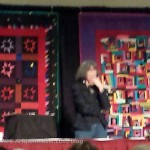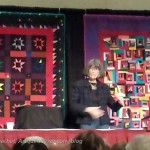As I said the other day, we attended lectures almost almost all day on Saturday. I am not sure why I signed up for such a marathon, but with one exception they were all very good.
Victoria Findlay Wolfe
My new hero. Have I said I want to be her new BFF? Actually I want to be her: tall, gorgeous, funny, kind and makes 14-20 quilt tops a week.
VFW’s lecture was called Creativity & Play/Process. This was a new lecture for her, so we were getting the unpracticed version. It wasn’t that she didn’t do a good job; she did. She just wasn’t as familiar with the flow of the words. Any of you who speak frequently in front of a crowd know how it is to work out the kinks on a new lecture.
To her, process and play are the same. Process should not stifle your creativity or imagination. We are often trained out of using our intuition, which means that we don’t know how to use intuition in our work. She encouraged us to think about and document how we work, think about the colors we always buy then rip the process apart and see what comes from changing it up.
She encouraged the audience to put a story into the quilt in order to make a connection with the quilt.
Having an idea in our heads doesn’t mean that the quilt will end up that way, which means we have to be open minded in our quiltmaking. You can always make them into something else by cutting them up or appliqueing on top or….?
Making creative decisions means you are an artist (NO arguing with me or her about that!), which, further, means we are all artists.
The next section of the talk was interesting. She discussed types of creative people. Her types were:
- Creative Self Doubter
- The Creative Starter Junkie
- The Creative Rule Abider
- The Creative Free Spirit
One of the things she asked after describing these creative types was which one we thought we were. As she described the types I kept thinking I was this one or that one, then I realized I had elements of all of them in me. I panicked a little until she said she had elements of all in her, too.
Some of the overarching themes I gleaned when she described the types were:
- let go, there is always more fabric
- If you aren’t having fun, find a new passion. Life is too short and we are all just doing our best.
- Making mistakes is a learning experience.
- We are all perfect in our imperfections.
- Stand up and show your quilt at your guild meeting. That is the only way to find your tribe
- Play like children play. They don’t know where the story is going, but they start playing anyway
- Chaos and creating go together
- Not all great ideas are great, but why not explore them?
- Quilts don’t always happen on your timetable.
- The more you work on a project and come back to it, the more it tightens up
- Surround yourself with creative people
- consider the following strategy for people who give unsolicited opinions:
- You hear it
- You decide if its accurate
- Let it go
- The more quilts you make the better you get at making them
- Slow down. Sit with the pattern or your sketchbook awhile longer. Sitting in the process awhile longer helps you make more connections
- Look for opportunities to learn
- Repeat techniques you learn so you can really master it
- think about what else you can do with a technique – something different than the teacher taught
- Make time; break it down into little morsels of time
- Every quilt is awesome. Your life will not end if the quilt isn’t awesome. Cut it up, change it, add something to it
I liked her advice and thinking about what she was saying. I realized that I did cut up a quilt once: the Renewed Jelly Roll Race. It was horrible and now it is actually a quilt I am not embarrassed to show people.
Gwen Marston
If you haven’t seen her speak, get there NOW! If you haven’t taken a workshop from her, do whatever it takes to get into her class. She is awesome.
You might remember that I took a 2 day workshop from her around 2003. I made the Women’s Work quilt, which is still part of a series that I haven’t worked on any further. I will do it; I just haven’t yet.
Gwen Marston is a funny, confident speaker. She engages with the audience very well. I felt mesmerized and riveted by her talk.
She will have a book out in August, A Common Thread, which will be retrospective of her work. [Pre-order now and support the blog by clicking on the title.]
She started making quilts when she saw a quilt show at a Mennonite church in Oregon. After that she went to the quilt group every week the whole year her family spent in Oregon. She only stopped going after er husband;s sabbatical was over and they returned to Michigan. She left with the knowledge to make quilts.
After that she got together with Mary Schafer. They both liked the irregularity of antique quilts and thought newer quilts seemed too coordinated and matchy-matchy. Antique quilts seemed spontaneous. She decided to model her quilts after vintage quilts.
Gwen wants spontaneity in her quilts. She embraced possibilities. She thinks good technique is important, but that an overabundance of concern about precision stifles creativity. She wants her quilts to be square with no ruffly edges.
When she makes a new quilt, she thinks about it as making up a new recipe – she gives herself parameters. She works a lot in solids, but also works with prints.
Gwen also talked about ghost blocks. These are blocks, or pieces of fabric that have no value change, so they disappear. Also, this concept is related to fabrics running together. When fabrics in different blocks run together, because they are the same or have the similar colors and values,they can merge into a block or piece next to them, changing the shape. Add bits and pieces to add interest and create new shapes
She kind of rocked my world about bindings. First, Gwen talked about Amish bindings. Amish bindings are on the straight of the grain. They put the sides on first and then the top and bottom. They do not miter the corners. I have never heard of this and have not checked it out. I also can’t imagine how they would finish the ends of the top and bottoms. Something to contemplate.
Then, she talked about how she uses single fold straight of the grain binding. I have always used a double fold bias binding. That was how I learned and I was always told they wear better. I was justified because I have never had a binding wear out. Gwen’s point was that if the binding wears out aren’t you going to replace the whole binding anyway? <—- Hhmmm
Gwen’s words of wisdom:
- Do your own work and don’t worry about what other people are doing
- Different sized blocks in one quilt add interest
- If you try stuff, some of it will not work. That is part of the game/process. Take a chance!
- Think about the practical or smart way to do something not the ‘right’ way.
I think I have a couple of more posts in me about random QuiltCon things, so stay tuned for those.


I’m so impressed all of that went in! hehe! Thanks for coming! ( and being such a good listener!) It was so nice to have you in class, I look forward seeing what else you create!
Thanks for reading and I am looking forward to getting back to the Pies and Points piece. I have some ideas that I want to try. Thanks for coming out.
What great insights! Thanks for sharing them here. I enjoy Victoria Findlay Wolfe, too. I have never met her but own 15 Minutes of Play and really loved making a quilt from made fabric.
Thank you so much for commenting! I am glad you enjoyed the post.